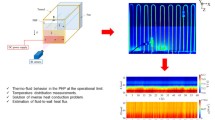Abstract
As a novel electronic cooling device, pulsating heat pipes (PHPs) have been received attention in recent years. However, literature survey shows that no studies were carried out on the start-up and steady thermal oscillation of the PHPs. In the present paper, the copper capillary tube was being bended to form the snake-shaped PHP. Heating power was applied on the heating section, and transferred to the condensation section and dissipated to the environment by the pure natural convection. The inside diameter of the capillary tube is 2.0 mm and the working fluid is selected as FC-72. A high speed data acquisition system was used to detect the start-up and steady thermal oscillation of the PHP. Two types of the start-up process were observed: a sensible heat receiving start-up process accompanying an apparent temperature overshoot followed by the steady thermal oscillation at low heating power, and a smooth sensible heat receiving start-up process incorporating a smooth oscillation period at high heating power. For the steady thermal oscillation, also two types were found: the random thermal oscillation with a wide frequency range, indicating the random distribution of the vapor plug and liquid slug inside the capillary tube at low heating power, and the quasi periodic thermal oscillation with the same characteristic frequency for both heating section and condensation section, indicating the uniform distribution of the vapor plug and liquid slug inside the capillary tube at high heating power. The power spectral density (PSD) was used to analyze the thermal oscillation waves. The frequency corresponds to the time that a couple of adjacent vapor plug and liquid slug passing through a specific wall surface.









Similar content being viewed by others
Explore related subjects
Discover the latest articles and news from researchers in related subjects, suggested using machine learning.Abbreviations
- d :
-
inside tube diameter (m or mm)
- g :
-
gravity acceleration (m/s2)
- H fg :
-
latent heat of evaporation (J/kg)
- P :
-
pressure (Pa)
- r :
-
radius (m)
- T :
-
temperature (°C)
- V :
-
velocity of the vapor plug/liquid slug
- ρ:
-
density (kg/m3)
- σ:
-
surface tension (N/m)
- α:
-
heat transfer coefficient (W/m2 K)
- ΔT:
-
temperature overshoot
- f:
-
liquid state
- liquid:
-
liquid state
- film:
-
thin liquid film
- g:
-
vapor state
- in:
-
inner wall surface
- sat:
-
saturation
- start-up:
-
start-up process
- w:
-
wall
References
Akachi H (1990) Structure of a heat pipe. United States Patent, Patent No. 4, 921, 041
Lee WH, Jung HS, Kim JH, Kim JS (1999) Flow visualization of oscillating capillary tube heat pipe. In: Proceedings of 11th international heat pipe conference, Tokyo, pp.131–136
Shafii MB, Faghri A, Yuwen Z (2001) Thermal modeling of unlooped and looped pulsating heat pipes. ASME J Heat Transfer 123:1159–1172
Shafii MB, Faghri A, Yuwen Z (2002) Analysis of heat transfer in unlooped and looped pulsating heat pipes. Int J Numerical Methods Heat Fluid Flow 12(5):585–609
Zhang XM, Xu JL, Zhou ZQ (2004) Experimental study of a pulsating heat pipe using FC-72, ethanol and water as working fluids. Exp Heat Transfer 17:47–67
Wang SF, Mosdorf R, Shoji M (2003) Nonlinear analysis on fluctuation of two-phase flow through a T-junction. Int J Heat Mass Transfer 46:1519–1528
Cai Y, Wambsganss MW, Jendrzejczyk JA (1996) Application of chaos theory in identification of two-phase flow patterns and transitions in a small, horizontal, rectangular channel. ASME J Fluid Eng 118:383–390
Acknowledgements
The authors would like to thank the natural science foundation of Guangdong Province, People’s Republic of China with the contract number of 32700.
Author information
Authors and Affiliations
Corresponding author
Rights and permissions
About this article
Cite this article
Xu, J.L., Zhang, X.M. Start-up and steady thermal oscillation of a pulsating heat pipe. Heat Mass Transfer 41, 685–694 (2005). https://doi.org/10.1007/s00231-004-0535-3
Received:
Published:
Issue Date:
DOI: https://doi.org/10.1007/s00231-004-0535-3




